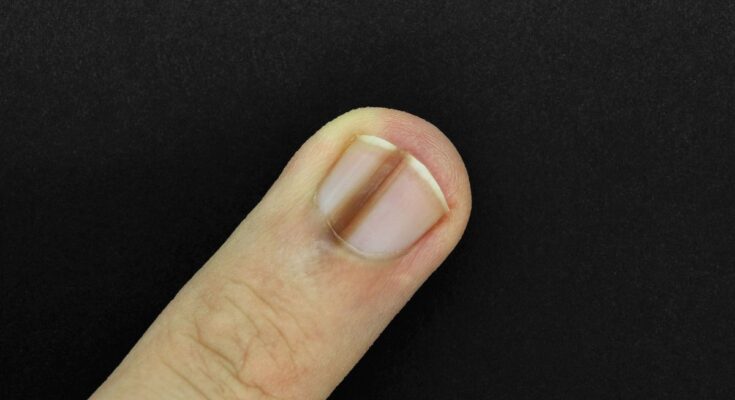Armed with prevention messages, we are used to inspecting our skin and our moles, but less often our nails, the spots and abnormalities that they may possibly present. However, it is important to study them regularly because they too can be affected by skin cancer, particularly melanoma. How to recognize nail melanoma? Who to consult to make a reliable diagnosis? How to treat this rare cancer located under the nail? Dr Sophie Goettmann, nail dermatologist and author, answers us.
What are the symptoms of this little-known skin cancer?
Over the past 30 years, the number of melanomas – the most serious form of skin cancer, developed from cells called melanocytes – has increased fivefold, according to figures provided by Health Insurance. An increase of more than 4% per year among men and more than 2.7% among women.
Uncommon, nail melanoma, more common in women, can develop under and around the nails, particularly under the nails of the thumb (hand) and big toe (foot).
“It most often manifests itself by the appearance of a longitudinal black band called longitudinal melanonychia. Sometimes confused with a pigmented mycosis, a hematoma, it should however require medical advice”describes Dr Sophie Goettmann, dermatologist and author of “Your nails, a whole world – Beautify – Prevent – Heal” (ed. Actes Sud).
If detected and treated in time, this nail cancer is indeed curable, assures the specialist. Self-examination is therefore essential to be able to take care of it early. The presence of melanonychia does not necessarily mean that it is a melanoma, but if in doubt, do not wait to show it to a dermatologist! Only an anatomopathological analysis can confirm the diagnosis with certainty.
Nail melanoma: what is it and what are the symptoms?
Nail melanoma is a melanoma, which has the particularity of developing under a nail, on the matrix and/or the nail bed.
“A melanoma is a cancerous tumor of the skin which develops from melanocytes, pigment cells of the epidermis. Like any malignant lesion, melanoma can spread in an anarchic manner, gaining the tissues neighboring the epidermis and then being able to produce metastases elsewhere in the human body Melanoma is not the most common skin cancer, but it is the most dangerous.explains Dr Sophie Goettmann.
When it appears on the nail or around the nail, we speak of “melanoma of the nail system”. This form of skin cancer is quite rare and represents between 2% and 8% of all skin melanomas. It progresses in the same way as a cutaneous melanoma, growing exponentially and uncontrollably and, if diagnosed late, spreading to other parts of the body. Cancer cells invade the lymph nodes close to the tumor and the lymphatic and blood vessels, and then spread to other organs and parts of the body (brain, liver, lungs, etc.), which is called metastasis.
In terms of appearance, nail melanoma initially presents, most often, in the form of a longitudinal pigmented band (“longitudinal melanonychia”), but also of a longitudinal red line (25% of nail melanomas are achromic) , rarely at the beginning, in the appearance of a sub or periungual nodule.
“The worrying characteristic is that the line widens slowly, gradually, the pigmentation can spill over onto the periungual skin (Hutchinson sign), a sign which should definitely raise the alarm”continues the specialist.
In more advanced forms, the nail deteriorates and/or peels off due to tumor proliferation of the matrix and/or nail bed. A budding tumor, a nodule or, on the contrary, an ulceration may appear. Total destruction of the nail is possible.
Most often, the nail of the thumb (hands) and big toe (feet) are affected, but melanoma can also appear on other nails.
These signs are sometimes difficult to recognize and can seem trivial when you are not a specialist. According to the American Academy of Dermatology (American Academy of DermatologyAAD), “Nail melanoma is often diagnosed at a more advanced stage than skin melanoma, which makes it more dangerous for health.. It is in fact sometimes confused with a bruise, following an impact on the toe or finger.
“Making the diagnosis at the pigmented band stage almost always ensures healing (superficial form in situ)”, reassures Dr Sophie Goettmann.
Better understanding the symptoms of this cancerous disease is therefore important to detect it early and, if necessary, treat it as quickly as possible. “This serious skin cancer is very well treated when it is “in situ”, at the intra-epidermal stage (without reaching deep into the dermis). Early treatment leads to complete recovery.”assures the dermatologist.
Are there other tumors that can affect the nail?
Melanoma is not the only tumor that can affect the nail. “Benign (non-cancerous) tumors and other malignant (cancerous) tumors can affect the nail: carcinomas. They all lead to an abnormality of the nail (what we call “dystrophy”)”, continues Dr Sophie Goettmann. The majority of these tumors originate from the tissues around the nail.
Benign tumors
- Fibrokeratomas : Small rolls of flesh appearing at the base of a longitudinal groove dug into the nail, often post-traumatic;
- Mucoid cysts : These benign swellings filled with fluid generally develop near the fingernails or toenails, in the fold above the nail (small firm nodule which by compressing the matrix draws a longitudinal groove on the surface of the nail), most often in people with osteoarthritis;
- L’onychomatricome : This rare tumor of the nail matrix is easily identifiable. It is characterized by a yellow band (longitudinal xanthonychia) with a thickening of the opposite nail, which runs the entire length of the nail, a longitudinal and transverse hypercurvature of the tablet;
- Pyogenic granulomas : These fleshy, moist or crusty nodules, red or reddish brown in color, slightly raised, bleeding, are made up of a proliferation of capillaries (smaller blood vessels) which causes swelling of the surrounding tissue. They often develop on the lateral folds, generally after ingrown toenail of the big toe. Achromic (non-pigmented) melanoma can manifest as a tumor that resembles pyogenic granuloma;
- Glomus tumors of the fingers : Any pain in an extremity should raise the diagnosis, especially pain on impact, pressure and cold. This benign tumor is located under the matrix or the nail bed or, more rarely, in the pulp. It arises from the glomus, a small receptor located at the fingertips allowing the extremities of the body to measure pressure, or temperature variations in the environment. This receptor is a microscopic tangle of nerves and small vessels. The glomus tumor thus arises from an abnormal multiplication of certain muscle cells making up the wall of these microscopic arteries.
Malignant tumors
- The Bowen disease : This disease is an early (in situ) form of squamous cell carcinoma, which affects the upper layer of the skin (epidermis) and has not yet invaded the deeper layers of the skin. “There is most often a chronic warty lesion at the bottom of a lateral furrow (between the nail and the lateral fold) and the nail can become detached.specifies the dermatologist;
- Squamous cell carcinoma : This tumor, also called squamous cell carcinoma, is most common in the nail (nail apparatus). It affects men more often (50 to 75% of cases, between 50 and 69 years old, and generally affects the fingers of the hands, particularly the thumb; more rarely the toes. The tumor affects the nail bed in 57% of cases and the paronychium (around the nail) in 32% of cases. In general, the diagnosis is late, both because the condition, which progresses slowly, is painless or simply sensitive to pressure; There are multiple presentations, often misleading. Patients therefore wait many years before consulting.
“Any mondactylic, unexplained, chronic damage under or around a nail deserves consultation and special attention (biopsy)”insists Dr Sophie Goettmann.
When the dermatologist suspects a carcinoma, he immediately carries out a large biopsy or even an excision; a restart with a safety margin will be made after confirmation of the diagnosis.
Who are the people at risk?
Melanoma can occur at any age but is more common in women after the age of fifty.
The phototype (light skin) should be taken into account, as should any family history. Melanoma is rare on dark skin but in this case, it occurs mainly on non-pigmented areas (palms, soles, nails).
According to the American Academy of Dermatology (AAD), personal or family history of melanoma or nail trauma can also constitute risk factors. Unlike skin melanoma, the sun does not play any role in nail melanoma.
“The role of trauma has been mentioned but not proven: most often, melanoma is discovered…




